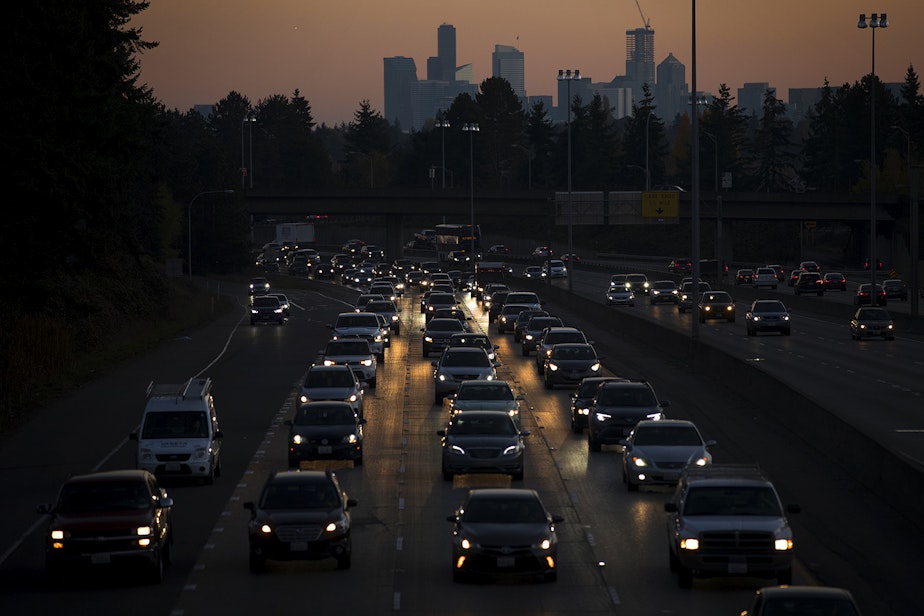Seattle launches new actions to tame transport’s climate impact

Seattle Mayor Bruce Harrell announced measures Tuesday to cut the city’s stubborn carbon emissions, including more electric-vehicle charging stations and a program for e-cargo bike deliveries.
For more than 20 years, mayors have been announcing actions to tame Seattle’s climate impacts, with mixed results.
To meet its science-based targets for helping the world hang on to a livable climate, Seattle needs to cut emissions nearly in half by 2030.
Halving emissions in five years would require a dramatic improvement in the city’s effectiveness at fighting climate change, especially in reining in tailpipe exhaust, the leading source of climate-harming pollution in Seattle and nationwide.
Seattle’s carbon dioxide emissions have mostly hovered around 6 million tons annually, despite years of programs to decarbonize the city.
“We don’t have the luxury of delay. Emissions are already sneaking back toward those pre-pandemic levels,” said Emily Pinckney, chair of the city’s oversight board for its Green New Deal law. “At this rate, we need to move 10 times faster to meet the urgency of this moment.”
Sponsored
Some measures in the executive order Harrell signed Tuesday aim to reduce traffic during major events such as construction on Interstate 5 or the 2026 men’s World Cup.
The city plans to close streets around Seattle Center, Pioneer Square, Pike Place Market, and the Chinatown-International District to vehicle traffic for World Cup matches and boost the use of transit and “micromobility” devices like scooters.
“We aim for 80% of fans to arrive without personal cars,” Seattle Department of Transportation interim director Adiam Emery said at the Earth Day signing ceremony at Mini Mart City Park, a former gas station in Seattle’s Georgetown neighborhood.
“With the average trip in Seattle being just over two miles, we have an amazing opportunity to flip short trips to the more sustainable modes,” Emery said.
Other measures in the executive order would accelerate the transition from gasoline to electricity for running Seattle’s motor vehicles.
Sponsored
At the national level, President Donald Trump has stopped a wide range of programs and funding to slow, study, and adapt to climate change.
Trump signed an executive order April 8 giving Attorney General Pam Bondi 60 days to assemble a list of supposedly illegal state and local laws on climate change and environmental justice and recommend measures to block them.
RELATED: West Coast governors: We will defend our climate policies against Trump attack
“My Administration is committed to unleashing American energy, especially through the removal of all illegitimate impediments to the identification, development, siting, production, investment in, or use of domestic energy resources,” Trump’s order states.
“Now more than ever, we think local action on climate is incredibly important,” Harrell said.
Sponsored
“This action here today demonstrates that Seattle will not back down from our work in addressing the climate crisis,” Seattle City Councilmember Alexis Mercedes Rinck said at the signing ceremony.
Rinck called the executive order a critical step but said it was not enough.
“The future of our city depends on climate action that leaves no one behind,” Rinck said. “I'm committed to pushing beyond incremental change towards transformative solutions that our community deserves.”
Some of the announced actions are not new, with the executive order directing agencies to continue efforts such as developing three “low-pollution neighborhoods” by 2028 in areas hard hit by air pollution and car crashes.
The Seattle Department of Transportation has been planning an e-bike cargo program since 2022. That program is to be launched by September to reduce pollution from ubiquitous cargo-delivery vehicles.
Sponsored
Seattle has been working for more than 20 years to slash its contribution to climate change, but rising populations of people and internal combustion engines have mostly thwarted those efforts.
This 2018 KUOW animation explores Seattle mayors’ long history of promises to protect the global climate.
Policies and technologies have kept the rapidly growing city’s pollution from worsening, but Seattle dumps almost as much heat-trapping exhaust into the sky as it did 20 or 35 years ago.
Several officials at the signing ceremony repeated the claim, long made by Seattle politicians, that the city is a leader in fighting climate change.
Sponsored
“We’re proud that Seattle has been a national and global leader on climate for decades,” Harrell said.
“We are number one on climate action,” Deputy Mayor Jessyn Farrell said.
The city’s 2013 climate action plan, to be updated by October 2026 under Tuesday’s executive order, calls for reducing emissions 58% below 2008 levels by 2030 and achieving carbon neutrality by 2050.
RELATED: Seattle a 'climate leader'? Our carbon emissions tell a different story
By 2022, Seattle’s emissions had fallen just 7% below the 2008 baseline and were trending upward, according to the city’s latest tally of its toll on the global climate.
Seattle’s Green New Deal law of 2019 committed the city to aim for zero emissions by 2030.
Instead, agencies have continued to embrace the less-daunting goal of zero climate pollution by the year 2050.
Pinckney called for Seattle to do more to both prevent and prepare for a hotter world.
“We are a sanctuary city. We are a climate refuge,” Pinckney said. “People come here and will continue to come here to seek safety, hope, and a new future. We must be ready.”




